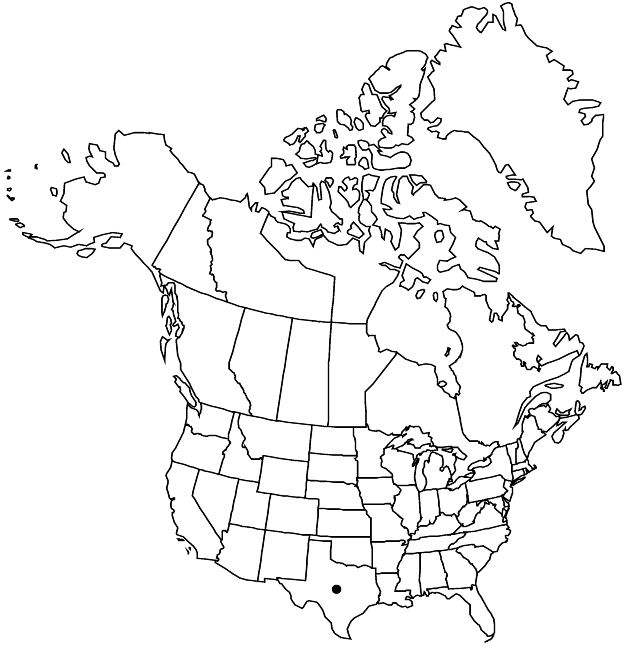Difference between revisions of "Malvastrum aurantiacum"
Ann. Bot. Syst. 2: 153. 1851.
FNA>Volume Importer |
FNA>Volume Importer |
||
| Line 34: | Line 34: | ||
|elevation=0–300 m | |elevation=0–300 m | ||
|distribution=Tex. | |distribution=Tex. | ||
| − | |discussion=<p>Malvastrum aurantiacum is easily distinguished from the other species of the genus in the flora area by its wide, auriculate involucellar bractlets and its raspberry-red fruits when fresh, these later drying brown.</p> | + | |discussion=<p><i>Malvastrum aurantiacum</i> is easily distinguished from the other species of the genus in the flora area by its wide, auriculate involucellar bractlets and its raspberry-red fruits when fresh, these later drying brown.</p> |
|tables= | |tables= | ||
|references= | |references= | ||
| Line 58: | Line 58: | ||
|publication year=1851 | |publication year=1851 | ||
|special status=Endemic | |special status=Endemic | ||
| − | |source xml=https://jpend@bitbucket.org/aafc-mbb/fna-data-curation.git/src/ | + | |source xml=https://jpend@bitbucket.org/aafc-mbb/fna-data-curation.git/src/8f726806613d60c220dc4493de13607dd3150896/coarse_grained_fna_xml/V6/V6_536.xml |
|subfamily=Malvaceae subfam. Malvoideae | |subfamily=Malvaceae subfam. Malvoideae | ||
|genus=Malvastrum | |genus=Malvastrum | ||
Revision as of 17:48, 18 September 2019
Subshrubs, 0.4–1 m, sparsely branched in proximal 1/2. Stems usually procumbent and ascending, hairs appressed, (6–)8–10-rayed, sublepidote. Leaves: stipules persistent, lanceolate, subfalcate, 4–6 × 1–1.5 mm, apex acute; petiole 10–25 mm; blade wide-ovate to ovate, unlobed or rarely with 2 obscure lateral lobes halfway from base, (1.8–)3–4(–5.5) × (1–)1.5–3(–4.5) cm, usually slightly (ca. 1.2 times) longer than wide, 2 times longer than petiole, base cordate to rounded or truncate, margins crenate-dentate, apex rounded, surfaces hairy, hairs scattered, appressed, (6–)8–10-rayed, sublepidote. Inflorescences axillary solitary flowers; floral bracts absent. Pedicels 3–5(–10) mm in flower, to 2 mm in fruit; involucellar bractlets basally adnate to calyx for 2–3 mm, deltate-cordiform in distal 4–6 mm, abruptly narrowed, 8–10 × 3–5 mm, shorter than calyx lobes, apex acute. Flowers: calyx connate 1/3–1/2 its length, broadly campanulate, lobes slightly auriculate at base, 11–12 mm, to 13–17 mm in fruit, surface hairy, hairs scattered, appressed, stellate-lepidote; corolla wide-spreading, golden yellow to pale orange-yellow, 30 mm diam., petals obovate, conspicuously asymmetrically lobed, 12–16 × 10–15 mm, exceeding calyx by 7–8 mm; staminal column 4 mm, glabrous; style 12–16-branched. Schizocarps 9–10 mm diam.; mericarps readily shed from calyx, 12–16, 4–6 × 4–6 × 1–1.5 mm, widely-notched, with 1 conspicuous, distally-directed, medial-apical cusp 1.5–2.3 mm and 2 distal-apical, contiguous, flattened, obtuse cusps 1 mm, surface sparsely hairy, hairs both erect and appressed, rigid, simple on apex and minute, stellate on dorsal 1/3, sides smooth. Seeds 2–3 mm. 2n = 36.
Phenology: Flowering spring–summer, into fall when sufficiently wet and warm.
Habitat: Restricted to heavy clay soil of river floodplains in prairies, especially in the Texas Coastal Bend
Elevation: 0–300 m
Discussion
Malvastrum aurantiacum is easily distinguished from the other species of the genus in the flora area by its wide, auriculate involucellar bractlets and its raspberry-red fruits when fresh, these later drying brown.
Selected References
None.
